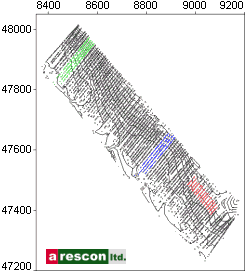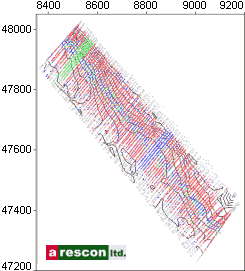An Approach to Seabed Classification from Multi-beam Bathymetric Sonar Data
![]()
![]() © April 2001
© April 2001
![]()
![]()
An Example
• Spatial relationships
Three training sets were selected from more or less arbitrary contiguous regions of the survey line in figure 2. Those beam subsets are shown in figure 5 with red, blue or green colored dots respectively.
Training sets "green" and "blue" reach across the whole swath and contain 4 pings each. Training set "red" contains off-nadir beams only. No background information about the sea-bottom geology was available, the red, blue and green areas are most likely totally unrelated to variations in the sea-floor and do not represent a true acoustic class. This somewhat artificial setup serves only one purpose: Any classification algorithm should recognize and classifiy members of the training-sets correctly within a larger data set.

Klick to enlarge
Figure 5: Location of the training sets "red", "blue" and "green".
The classification result is shown in figure 6. With the exception of a few beams, all data from the training sets have been classified correctly. The exceptions may serve to point out that the proposed classification scheme is a competitive one. Class memories virtually compete for a sample, which is presented to them. Whenever classes overlap in their statistical distribution, the fuzzy classifier assigns the most likely class membership. Consequently a training set member may end up in a different class whenever its statistics resemble the foreign class more closely.

Klick to enlarge
Figure 6: The line after all beams have been classified.
The training sets are classified correctly.
Any remaining black dots designate "no class",
their confidence level was too small to warrant a classification.
The apparent dominance of class "red" in the classified profile is to some degree an illusion created by overlapping dots:red dots were plotted last, on top of the blue and green ones. A final processing step will remove that artifact.
Spatial relationships
So far, the classification scheme is spatially "un-aware", i.e. the spatial relationships of neighboring beams are not considered. Beams may be classified in any random order. Since it can be expected that sea-bottom geology is uniform over contiguous regions, that a-priory knowledge should be represented in a classification scheme. This is accomplished in a very straight-forward manner. The geo-referenced and classified field of beams is spatially filtered. The filter weights are the confidence values accompanying each class assignment. The class membership of an individual beam thus becomes dependent on the class membership of its neighbors weighted by the respective confidence values. The spatial filter can at the same time be used for a reduction of the data, as it has been done in the example shown in figure 7.

Klick to enlarge
Figure 7: Spatially "aware" classification.
Neighbors have a vote, weighted by their own confidence value,
to decide a beams class membership. Circle size represents confidence level.
Class "green" looses competition with class "blue" outside the training set.
The highest confidence values (biggest circles) occur within the training sets. This just confirms the earlier conclusion, that the network is well suited to recognize patterns it has been trained with. Outside the training sets the result is less conclusive. Obviously class "green" and class "blue" have very similar properties. Beam by beam classification as shown in figure 6 results in interspersed green and blue dots. When confidence values and neighboring beams are considered as in figure 7, class "blue" wins over "green" almost anywhere outside the training sets, due to higher confidence values. The filtered result in figure 7 now also shows a clear preference of "blue" for nadir and near-nadir beams, while "red" dominates the beams with greater incident angles. The "red" training set did not contain any nadir exemplars and it is rather a surprise that in the north-west and south-east parts of the line, some of the nadir beams nevertheless classify "red".
However, the general behavior, that, with statistically very in-homogenous, arbitrary classes, which most likely overlap, the system locks on to whatever salient differences remain, is rather promising.